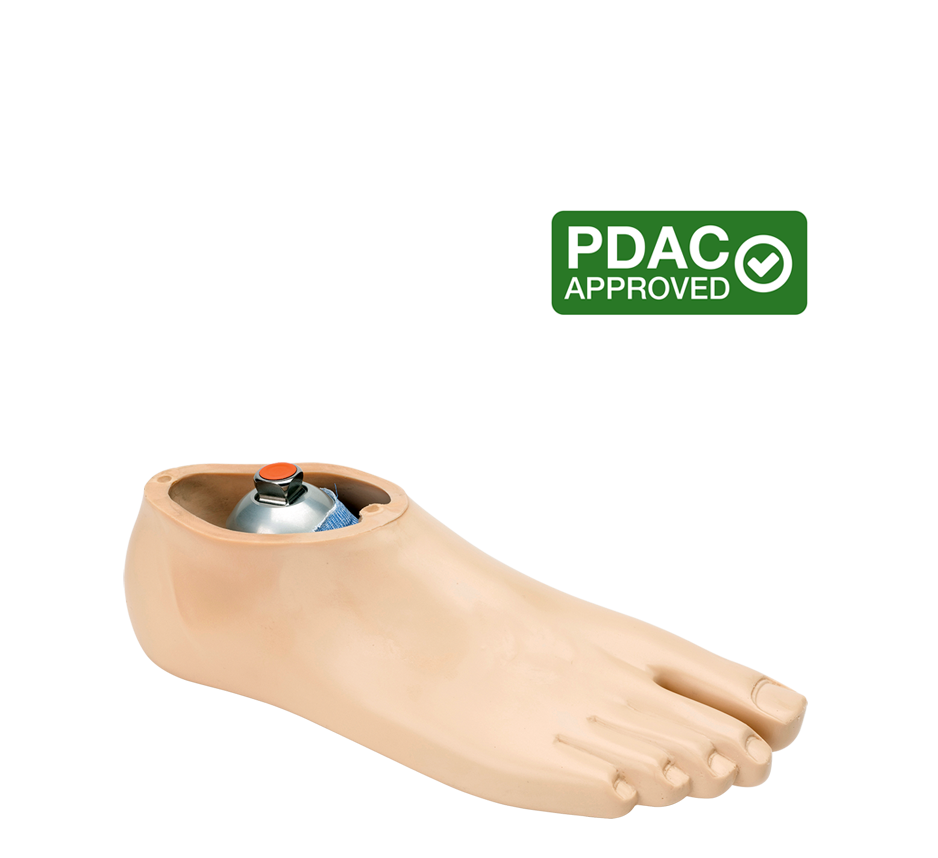Navigator
The stability and comfort provided by the navigator multi-axial prosthetic foot with flexible keel ensures that activity level 2 users are safer on uneven ground. The ankle center is positioned anatomically to promote a natural gait from heel strike to toe off.
- Activity level 1
- Activity level 2
- Suitable for outdoor use
- Activity level 3
Navigator Clinical Evidence Reference
Clinical Outcomes using Navigator
-
Mobility
- Shorter keel allows for more consistent rollover radius of curvature, regardless of changing footwear1
- The most energy efficient radius of curvature for a rollover shape has been identified as 30% of the walker’s leg length. For a person of a typical adult height between 1.5m and 1.8m, this equates to approximately 245-290mm. Navigator has a rollover shape of ~250mm1.
Clinical Outcomes using Multiflex-style ankles
-
Safety
- Low stiffness at weight acceptance leads to early foot-flat and greater stability for lower mobility patients15
- No loss of stability during standing with Multiflex than fixed ankle/foot16
- Easier to walk on uneven ground with Multiflex than fixed ankle/foot16,17
- Easier to walk up a slope with Multiflex than fixed ankle/foot16
-
Mobility
- Little to no difference in gait mechanics compared to flexible, “energy storing” prosthetic feet18
- Increased prosthetic ankle range-of-motion with Multiflex compared to fixed ankle/foot16,17,19-21
- Increased prosthetic ankle power with Multiflex compared to fixed ankle/foot17
- Prosthetic rollover shape closer to natural biomechanics than fixed ankle/foot19
- Users can walk longer distances and report “smoother” gait with Multiflex compared to fixed ankle/foot17
- Benefits in mobility for bilateral users17,19-21
-
Residual Limb Health
- Equivalent socket comfort to higher technology, energy-storing feet22
-
Loading symmetry
- Improved stance phase timing symmetry with Multiflex compared to fixed ankle/foot21
- Reduced sound limb loading with Multiflex compared to fixed ankle/foot21
-
User satisfaction
- Majority of users rate Multiflex as either “good” or “acceptable”23 and prefer Multiflex to fixed ankle/foot17
References
-
Full Reference Listing
-
Curtze C, Hof AL, van Keeken HG, et al.
Comparative roll-over analysis of prosthetic feet. J Biomech 2009; 42: 1746–1753.
-
Moore R.
Patient Evaluation of a Novel Prosthetic Foot with Hydraulic Ankle Aimed at Persons with Amputation with Lower Activity Levels. JPO J Prosthet Orthot 2017; 29: 44–47.
-
Moore R.
Effect on stance phase timing asymmetry in individuals with amputation using hydraulic ankle units. JPO J Prosthet Orthot 2016; 28: 44–48.
-
Buckley JG, De Asha AR, Johnson L, et al.
Understanding adaptive gait in lower-limb amputees: insights from multivariate analyses. J Neuroengineering Rehabil 2013; 10: 98.
-
Sedki I, Moore R.
Patient evaluation of the Echelon foot using the Seattle Prosthesis Evaluation Questionnaire. Prosthet Orthot Int 2013; 37: 250–254.
-
Rogers JP, Strike SC, Wallace ES.
The effect of prosthetic torsional stiffness on the golf swing kinematics of a left and a right‐sided trans‐tibial amputee. Prosthet Orthot Int 2004; 28: 121–131.
-
Kobayashi T, Orendurff MS, Boone DA.
Dynamic alignment of transtibial prostheses through visualization of socket reaction moments. Prosthet Orthot Int 2015; 39: 512–516.
-
Wright DA, Marks L, Payne RC.
A comparative study of the physiological costs of walking in ten bilateral amputees. Prosthet Orthot Int 2008; 32: 57–67.
-
Vanicek N, Strike SC, Polman R.
Kinematic differences exist between transtibial amputee fallers and non-fallers during downwards step transitioning - Natalie Vanicek, Siobhán C Strike, Remco Polman, 2015. ProsthetOrthot Int 2015; 39: 322–332.
-
Barnett CT, Vanicek N, Polman R, et al.
Kinematic gait adaptations in unilateral transtibial amputees during rehabilitation: Prosthetics and Orthotics International: Vol 33, No 2. Prosthet Orthot Int 2009; 33: 135–147.
-
Emmelot CH, Spauwen PHM, Hol W, et al.
Case study: Trans‐tibial amputation for reflex sympathetic dystrophy: Postoperative management. Prosthet Orthot Int 2000; 24: 79–82.
-
Boonstra AM, Fidler V, Eisma WH.
Walking speed of normal subjects and amputees: Aspects of validity of gait analysis. Prosthet Orthot Int 1993; 17: 78–82.
-
Datta DD, Harris I, Heller B, et al.
Gait, cost and time implications for changing from PTB to ICEX® sockets. Prosthet Orthot Int 2004; 28: 115–120.
-
Castro M de, Soares D, Mendes E, et al.
Center of Pressure Analysis During Gait of Elderly Adult Transfemoral Amputees. J Prosthet Orthot 2013; 25: 68–75.
-
Major MJ, Scham J, Orendurff M.
The effects of common footwear on stance-phase mechanical properties of the prosthetic foot-shoe system. Prosthet Orthot Int 2018; 42: 198–207.
-
McNealy LL, Gard SA.
Effect of prosthetic ankle units on the gait of persons with bilateral trans-femoral amputations. Prosthet Orthot Int 2008; 32: 111–126.
-
Su P-F, Gard SA, Lipschutz RD, et al.
Gait characteristics of persons with bilateral transtibial amputations. J Rehabil Res Dev 2007; 44: 491–502.
-
Boonstra A, Fidler V, Spits G, et al.
Comparison of gait using a Multiflex foot versus a Quantum foot in knee disarticulation amputees. Prosthet Orthot Int 1993; 17: 90–94.
-
Gard SA, Su P-F, Lipschutz RD, et al.
The Effect of Prosthetic Ankle Units on Roll-Over Shape Characteristics During Walking in Persons with Bilateral Transtibial Amputations. J Rehabil Res Dev 2011; 48: 1037.
-
Major MJ, Stine RL, Gard SA.
The effects of walking speed and prosthetic ankle adapters on upper extremity dynamics and stability-related parameters in bilateral transtibial amputee gait. Gait Posture 2013; 38:858–863.
-
Van der Linden ML, Solomonidis SE, Spence WD, et al.
A methodology for studying the effects of various types of prosthetic feet on the biomechanics of trans-femoral amputee gait. J Biomech 1999; 32: 877–889.
-
Graham LE, Datta D, Heller B, et al.
A comparative study of conventional and energy-storing prosthetic feet in high-functioning transfemoral amputees. Arch Phys Med Rehabil 2007; 88: 801–806.
-
Mizuno N, Aoyama T, Nakajima A, et al.
Functional evaluation by gait analysis of various ankle-foot assemblies used by below-knee amputees. Prosthet Orthot Int 1992; 16: 174–182
-
The PDAC-Approved badge denotes a product that has been approved by the Pricing, Data Analysis and Coding (PDAC) contractor for one or more of the prior authorization codes as specified in the Healthcare Common Procedure Coding System (HCPCS) codes.



